Customer Logins
Obtain the data you need to make the most informed decisions by accessing our extensive portfolio of information, analytics, and expertise. Sign in to the product or service center of your choice.
Customer Logins
ECONOMICS COMMENTARY
Aug 03, 2017
Developed world powers steady global upturn at start of third quarter
The global economy saw growth ease very slightly for a second successive month in July but nevertheless enjoyed a solid start to the second half of 2017, according to the latest PMI data. The divergence between the developed and emerging markets remained the widest seen for one-and-a-half years, amid subdued growth in the latter, underscoring the continued relative outperformance of the developed world, and the eurozone in particular.
Global growth slowest so far this year
The headline JPMorgan PMI, compiled by IHS Markit, slipped further from May's recent peak, down from 53.7 in June to 53.5 in July. The latest reading was the lowest since December.
Global economic growth
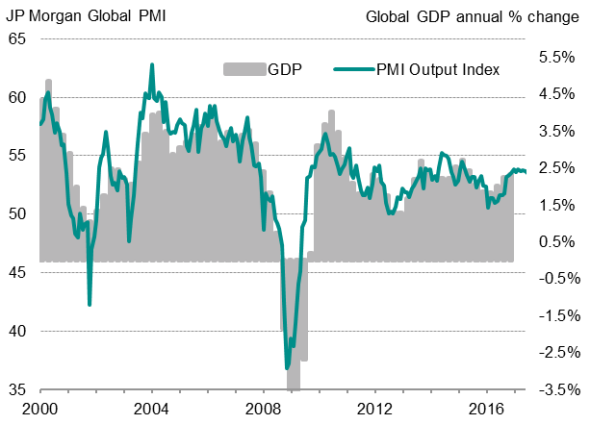
While the PMI hints at a mild slowing in the rate of economic growth, the level remains consistent with a relatively robust GDP increase at the start of the third quarter. Historical comparisons show that the July PMI indicates that global GDP is rising at an annual rate of just under 2.5%, only slightly below that seen on average over the course of the first half of 2017.
Some survey indices suggest growth could pick up in August. Inflows of new business showed the largest rise since January and one of the biggest gains seen for almost three years. At the same time, employment growth reached a three-year high.
Global employment and new orders
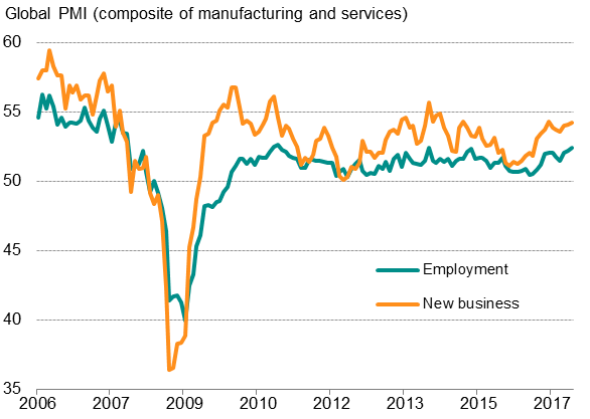
However, companies' expectations of their own output levels in a year's time fell to the lowest since December, suggesting a less rosy longer-term outlook than seen in prior months.
Prices charged also rose at a slightly reduced rate, often linked to a lack of pricing power amid relatively weak demand, as well as slower growth of input costs compared to earlier in the year.
Global prices
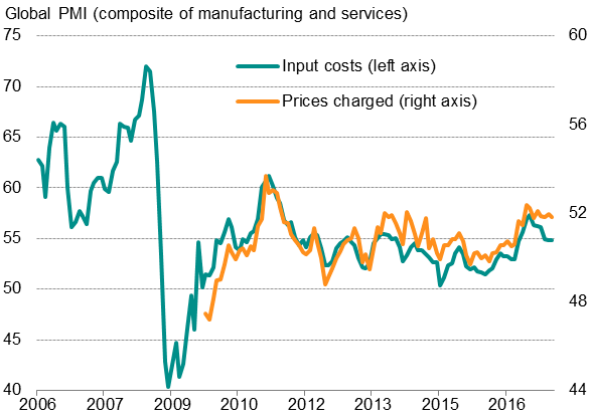
Sources for charts: IHS Markit, JPMorgan, Nikkei, Caixin.
Emerging market malaise
Beneath the headline numbers, the survey data showed that growth was once again driven by the developed world. The developed world PMI edged down marginally from 54.5 to 54.4, but continued to run at one of the highest levels seen over the past two years. The emerging markets PMI meanwhile fell from 51.5 to 51.4, its lowest since last September, indicating that the underperformance of the emerging markets relative to the developed world remained the widest since January 2016.
Developed and emerging market growth
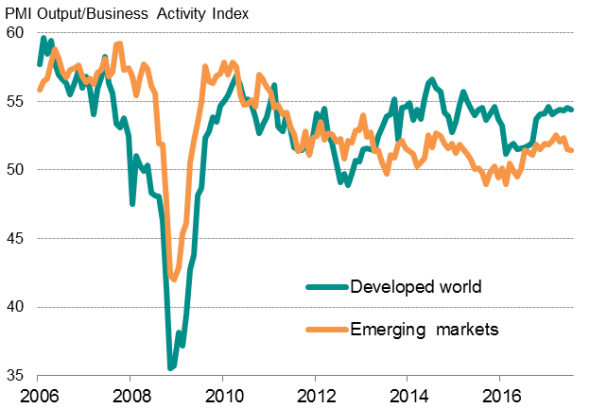
Employment trends also diverged, with emerging market payroll numbers falling slightly while job growth in the developed world rose to its highest since October 2007.
Future expectations dipped in both the developed and emerging markets, albeit merely down to a four-month low in the former while the latter saw sentiment drop to its lowest for one-and-a-half years.
Developed and emerging market employment
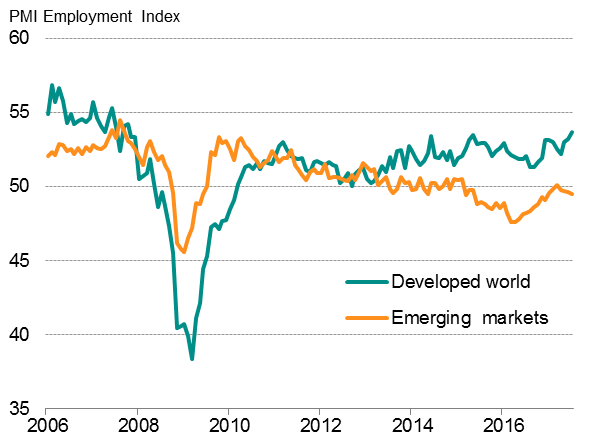
India drives EM slowdown
Part of the weakness in the emerging markets could be blamed on a steep fall in business activity in India, in turn linked to the new sales tax. The drop in activity signalled by the Nikkei PMI was the steepest for just over eight years and contrasts with the reviving trend seen in India in prior months.
July also brought disappointing news on Russia, where the PMI surveys registered the smallest rise in business activity for ten months.
Brazil remained in contraction, albeit only slightly, suggesting that the brief return to growth seen in April and May has faltered.
In contrast, there was better news out of China, where the Caixin PMI surveys picked up from June's one-year low, edging just higher than the average seen over the first half of the year to suggest a modest upturn in growth. Faster (export-led) manufacturing growth offset a slowdown in services.
Emerging market output
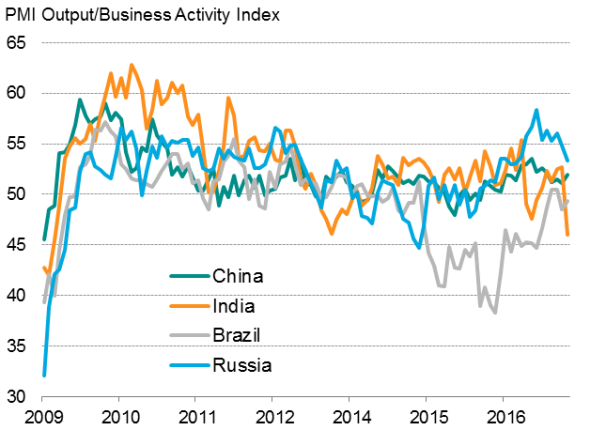
Sources for charts: IHS Markit, JPMorgan, Nikkei, Caixin.
US closes the gap with eurozone
Although the Eurozone PMI signalled slightly softer growth for a second successive month in July, the region outperformed its peers for a sixth straight month. The current PMI is broadly consistent with 0.6% quarterly GDP growth, and also indicated one of the best job market gains seen over the past 20 years.
The US PMI closed the gap with the eurozone, registering the strongest expansion since January, though continued to indicate a relatively moderate annualised rate of GDP growth (in the region of 2%). Job creation continued to run at a healthy rate indicative of around 200,000 payroll gains per month.
UK
The UK PMI surveys indicated that businesses remain in expansion-mode despite heightened uncertainty about the outlook, but also highlighted how the risks to future growth remain firmly biased to the downside. The surveys are broadly consistent with economic growth of just over 0.3%, putting the country on course for another steady but sluggish expansion in the third quarter.
However, UK firms' prospects for the coming year were running at a level which has previously been indicative of the economy stalling or even contracting, having taken a further lurch downward since June's general election, largely reflecting ongoing uncertainty about the economic outlook and Brexit process.
Japan
Finally, Japan's economy lost further growth momentum in July. The Nikkei PMI surveys signalled a weaker pace of expansion for a second consecutive month to register the smallest rise in business activity since last October. Manufacturers reported the smallest upturn in output for ten months, in part due to slower export growth, while service providers reported the smallest increase in activity since February. The surveys nevertheless still suggest the economy continued to grow at an annual rate approaching 2%.
Developed world output
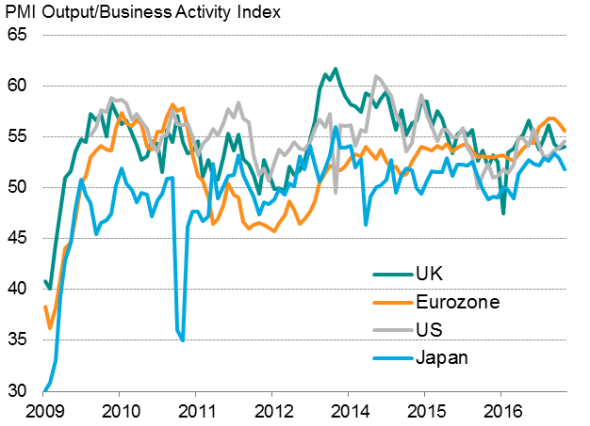
Sources for charts: IHS Markit, JPMorgan, Nikkei, Caixin.
Chris Williamson | Chief Business Economist, IHS Markit
Tel: +44 20 7260 2329
chris.williamson@ihsmarkit.com
{"items" : [
{"name":"share","enabled":true,"desc":"<strong>Share</strong>","mobdesc":"Share","options":[ {"name":"facebook","url":"https://www.facebook.com/sharer.php?u=http%3a%2f%2fstage.www.spglobal.com%2fmarketintelligence%2fen%2fmi%2fresearch-analysis%2f03082017-Economics-Developed-world-powers-steady-global-upturn-at-start-of-third-quarter.html","enabled":true},{"name":"twitter","url":"https://twitter.com/intent/tweet?url=http%3a%2f%2fstage.www.spglobal.com%2fmarketintelligence%2fen%2fmi%2fresearch-analysis%2f03082017-Economics-Developed-world-powers-steady-global-upturn-at-start-of-third-quarter.html&text=Developed+world+powers+steady+global+upturn+at+start+of+third+quarter","enabled":true},{"name":"linkedin","url":"https://www.linkedin.com/sharing/share-offsite/?url=http%3a%2f%2fstage.www.spglobal.com%2fmarketintelligence%2fen%2fmi%2fresearch-analysis%2f03082017-Economics-Developed-world-powers-steady-global-upturn-at-start-of-third-quarter.html","enabled":true},{"name":"email","url":"?subject=Developed world powers steady global upturn at start of third quarter&body=http%3a%2f%2fstage.www.spglobal.com%2fmarketintelligence%2fen%2fmi%2fresearch-analysis%2f03082017-Economics-Developed-world-powers-steady-global-upturn-at-start-of-third-quarter.html","enabled":true},{"name":"whatsapp","url":"https://api.whatsapp.com/send?text=Developed+world+powers+steady+global+upturn+at+start+of+third+quarter http%3a%2f%2fstage.www.spglobal.com%2fmarketintelligence%2fen%2fmi%2fresearch-analysis%2f03082017-Economics-Developed-world-powers-steady-global-upturn-at-start-of-third-quarter.html","enabled":true}]}, {"name":"rtt","enabled":true,"mobdesc":"Top"}
]}





